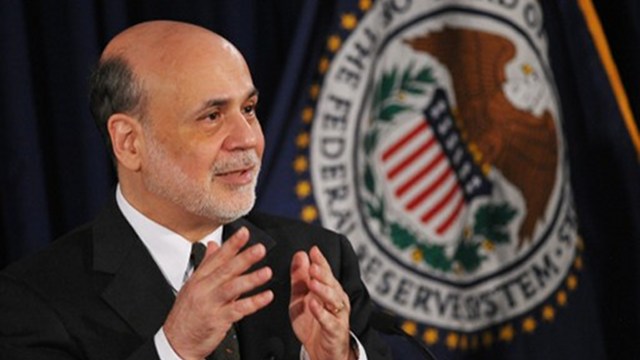SUMMARY
This is AI generated summarization, which may have errors. For context, always refer to the full article.

WASHINGTON, USA – Federal Reserve Chairman Ben Bernanke said Wednesday, June 19 (June 20 in Manila) that the Fed could begin to ratchet down its key stimulus program later this year, signaling a growing confidence in the US economy.
The Fed’s policy board kept its quantitative-easing program, aimed at holding interest rates down, locked in place for the meantime, saying that unemployment remains high and growth is still being held back by government spending cuts.
But Bernanke said that if growth continues to pick up pace, the Fed could begin reeling in the $85 billion-a-month in bond purchases sometime later this year, and bring the operation to a close by mid-year 2014.
Stressing that “our purchases are tied to what happens in the economy,” Bernanke said that most of the members of the Federal Open Market Committee foresaw tapering the key stimulus program in the coming months.
“The committee currently anticipates that it will be appropriate to moderate the monthly pace of purchases later this year,” he told reporters after the FOMC meeting ended.
In addition, he said, if the FOMC’s current forecasts for the economy are met, “we will continue to reduce the pace of purchases in measured steps through the first half of next year, ending purchases around mid-year.”
Bernanke’s comments confirmed market expectations that the Fed sees growth tentatively firm enough to begin pulling back the quantitative-easing (QE) program, which aims at holding longer-term interest rates down.
His words sent bond prices and stocks down while the dollar climbed sharply, all in anticipation that an era of rock-bottom interest rates was near an end.
The S&P 500 closed down 1.4% and the 30-year Treasury bond yield jumped to 3.41% from 3.34%. The euro sank 0.8% against the dollar, to $1.3287.
“The market is now expecting a faster rate of Fed funds rate hikes starting in mid-2015,” said Chris Low of FTN Financial.
US bond prices had already sunk interest rates and pushed higher over the past month in expectation that the Fed was close to turning the corner on five years of efforts to boost US growth, since the economic crisis erupted in 2008.
The FOMC said in its policy statement the economy continues to grow at a “moderate” pace and that downside risks had eased, but it added that tightened fiscal policy “is restraining economic growth.”
“Labor market conditions have shown further improvement in recent months, on balance, but the unemployment rate remains elevated,” the FOMC said pointedly, indicating its ongoing dissatisfaction with the pace of job creation.
The Fed policy board eased its growth forecast for the US economy this year slightly to 2.3% to 2.6%, while raising it for 2014 to 3% to 3.5%.
But, the forecasts show, the Fed clearly sees improvement ahead in the economy despite sharp government spending cuts.
It expects the jobless rate will fall faster than it predicted just three months ago, to as low as 7.2% by the end of the year from the current 7.6%, and to as low as 6.5% by the end of 2014.
At the same time, it sees inflation as even weaker that it did in March, and posing little threat despite the continuation of its easy-money QE policy and its ultra-low benchmark interest rate, at 0% to 0.25% since December 2008.
Bernanke stressed that slowing the QE asset purchases was not the same as tightening monetary policy — it was like “letting up a bit on the gas pedal as the car picks up speed, not beginning to apply the brakes,” he said.
The economy still remains far from the Fed’s thresholds of a 2% inflation rate and 6.5% unemployment rate before it would begin increasing its interest rate to a more normal level, he said.
That “is still far in the future,’ he said.
While the markets moved sharply, Bernanke’s details on Fed thinking generally confirmed the direction in which most analysts said the Fed was headed, given the slow but sure pace of US economic growth.
But some analysts said the Fed was too confident in the US economy, arguing the it remains vulnerable to both domestic spending cuts and slower growth in Europe and China.
“We think the Fed is too optimistic, and that unemployment won’t fall below 7.5% this year. So we question whether the Fed will end up tapering before 2014,” said economist Paul Edelstein of IHS Global Insight. – Rappler.com
Add a comment
How does this make you feel?
There are no comments yet. Add your comment to start the conversation.